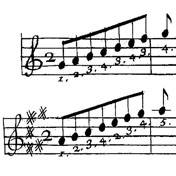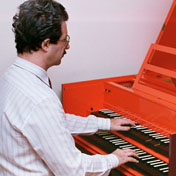Excerpts from this book:
Fingering example by François Couperin from his L'Art De toucher le Clavecin, Paris 1717, p. 71, for his piece L’Atalante.
INTRODUCTION
Every keyboard player who has tried to play F. Couperin's Pièces following his fingering system, knows too well that the attempt is fraught with difficulties. This is because L'Art de Toucher, although a a very significant source of information about French Baroque fingering, is far from being a comprehensive treatise about technique and interpretation. ... Fortunately, it can be said that virtually all the Baroque “cross-fingering rules” documented elsewhere are also found in L'Art de Toucher. It is then a matter of putting together what we can deduce from it—as shown in the present author's Baroque fingering method—and applying the result in a systematic way to Couperin's pieces. Our editions—the previous Vol. I and the present Vol. II—are meant to share this experience among both students and colleagues.
FINGERING PRINCIPLES
In the Baroque era, an amateur player surely did not have in mind the multiple finger crossings available. She/he would finger a piece not worrying if a less-than-adequate finger here and there yielded an irregular rhythm or articulation. A professional and teacher, such as François Couperin, thought differently, and recommended fingerings that facilitated—as much as possible—the desired control of performance down to the smallest details. For most pieces the fingering in this edition is the author's hypothetical historical reconstruction of the fingering the composer would have approved of.
DETAILS ON THE PERFORMANCE OF EACH PIECE
...
Le Carillon de Cithére
An allusion to a mythical carillon in Cythera, the Greek island. From this Couperin has produced one of his best-known masterpieces.
REGISTRATION. Single 8'. The more nasal upper 8' fits very well the character of the piece.
PERFORMANCE. Sans lenteur, warns the composer. We also warn sans vitesse! In a metre where customarily the semiquavers would be inégales, the composer tells us—either with staccato dots or with legato slurs—to do égales instead.
ORNAMENTS. Sadly, most recordings include a few prebeat ornaments. Please don’t! Let us stress once more that prebeat mordents and trills were unheard of in French Baroque musical practice: in expressive melodic instruments the ornament’s first note was played slightly louder than the rest of the ornament, and either fell strictly on the beat or very slightly after the beat (“staggered execution”), never before the beat.
THE QUIRK. Here FC has again a sign like “w∕” within a bar instead of a note:
We already discussed this for Les Fauvétes Plaintives, and here also B&C considers the sign as a rest while HG prints it as an optional small note: we have mostly followed this reading. Note however that, except for bar 36, in this piece these notes are all playable on a single manual.
...
Les Gondoles de Delos
Surely an allusion to the Greek city, sacred to Apollo: in Versailles the “bassin de Apollon” had indeed gondoles, a gift from the republic of Venice.
REGISTRATION. Single 8'. We prefer the lower 8', except for the 3e Partie, in f minor, where we suggest using the upper 8'.
PERFORMANCE. The semiquavers are inégales, and when the composer wants them strong in bars
14-15 he writes dotted pairs. (Rameau also dotted pairs, reinforcing previous inégales, in his Premier Livre of 1706, Sarabande, bars 25-26). Sometimes this effect produces a “staggered (arpeggio) execution” when the r.h. strikes very slightly after the l.h., as in bars 2, 9 and 10 of the 1re PARTIE. In the 3e PARTIE there is a hemiola in bars 13-14.
Les Petits Moulins à Vent
Small windmills: a toy perhaps. Another long-time favourite of the harpsichord repertoire.
REGISTRATION. Mock-furious 8'+4'.
PERFORMANCE. Most semiquavers are égales because of the fast Tres Légérement tempo. However, a slight inégalité in the passages in scales (bars 12-17 and 42-48) is very stylish, and almost inevitable with a pairwise fingering.
RANGE. Most harpsichords at the time still did not have the FF#, but if you have it, feel free to use it in bar 44 as suggested, by analogy with bar 14.
...



